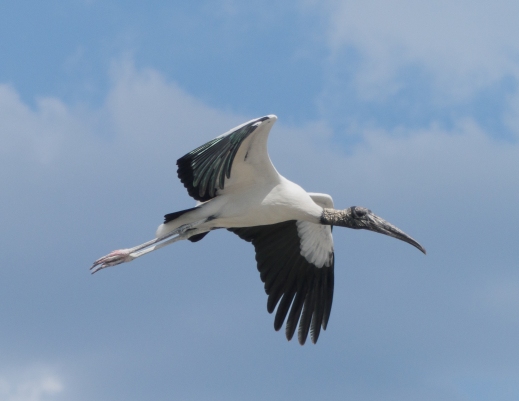The Star of the Day today could have been the pelicans, which were quite photoworthy.
 Or it could have been any of the number of small waders that ran along the shore and entertained us by pestering each other.
Or it could have been any of the number of small waders that ran along the shore and entertained us by pestering each other.
But The Star of the Day was none of these.
It was definitely the wood stork.
And not just *any* wood stork.
It was THIS wood stork, whose personality outshone all the other birds we saw on Day 4.
However, we wouldn’t know that until the afternoon.
 The morning of Day 4 was spent re-visiting the spoonbills at a nearby lake.
The morning of Day 4 was spent re-visiting the spoonbills at a nearby lake.
They were just as busy on Day 4 as they had been a few days earlier, gathering and delivering nesting materials.
There were other birds that caught my attention and stayed still long enough to allow me to practice and improve my focus-locking and tracking skills.
After these practice shots, I did much better on birds-in-flight, although it is clear I still have a long way to go.
At least the birds in these images are recognizable as birds! and not the fuzzy blobs that characterized my past attempts at BIF.
 The wifi table at McDonald’s allowed me to spend the harsh-light hours reviewing and post-processing my photos.
The wifi table at McDonald’s allowed me to spend the harsh-light hours reviewing and post-processing my photos.
And it was during this time that I learned my next lesson. Noisy images.
Since the M4/3 sensor is small (17 x 13 mm) its photo receptors are also small, especially if there are more of them. They can absorb only so much light and not nearly as much as full-frame sensors. So, noise can be a problem. What I learned, though, in reviewing and post processing, was that this doesn’t have to be a problem if you use every single photon of available light.
Underexposed images will definitely harbor a lot of noise, even with cameras that have larger sensors, but images that utilize as much available light as possible (without overexposing, that is) — not so much.
 If noise is present, it will be found in the dark areas of the photo; hence, the importance of avoiding underexposure.
If noise is present, it will be found in the dark areas of the photo; hence, the importance of avoiding underexposure.
And it tends to affect the background more than the subject, if the subject is sharply focused.
At least, that’s what I found in my Day 4 photos.
The afternoon golden hours finally arrived, and with them the Star of the Day.
This wood stork had Personality (with a capital P!).
Not willing to expend energy in unnecessary hunting, it simply ambled up and down the shoreline looking for handouts.
 An empty bucket must have smelled of fish, because our wood stork kept checking it out. Disappointed, it looked for other buckets that might hold lunch. . .
An empty bucket must have smelled of fish, because our wood stork kept checking it out. Disappointed, it looked for other buckets that might hold lunch. . .
. . .such as kids’ sand pails.
Disappointed again!
We turned our attention to activities of other birds, but the stork returned several times to check out the shoreline and any buckets left thereon.
It was both amusing and amazing to watch.
 Now, stork antics aside, I can’t forget the pelicans.
Now, stork antics aside, I can’t forget the pelicans.
The pelicans were both numerous and interesting.
The rocks were painted with their whitewash, revealing which ones were favorite resting places.
They, too, declined to hunt for their dinner, but that’s okay. Instead, the begged for their dinner.
There was one who performed several tricks and displays trying to entice a fisherman to hand over some dinner.
The pelican was unsuccessful, but our friend the stork did catch the fish that the fisherman had tossed its way.
 But that was it. If either the stork or the pelican was going to eat anything more, they had to do its own legwork.
But that was it. If either the stork or the pelican was going to eat anything more, they had to do its own legwork.
More photos from Day 4.
Some good, some not so good, but all in all a great day of learning and practice.













Recent Comments